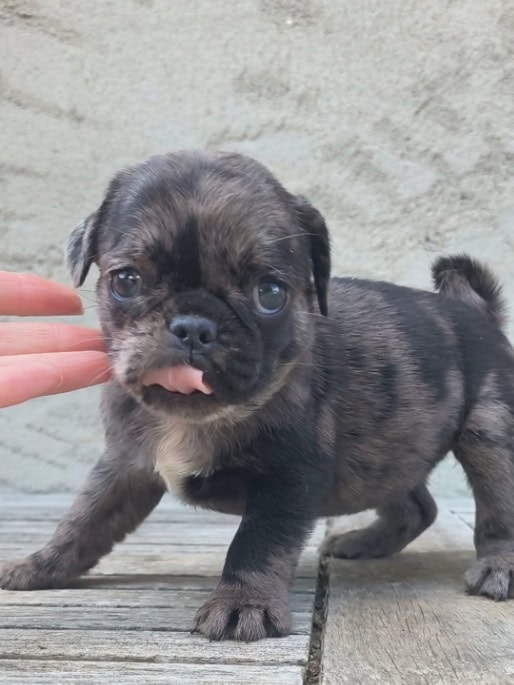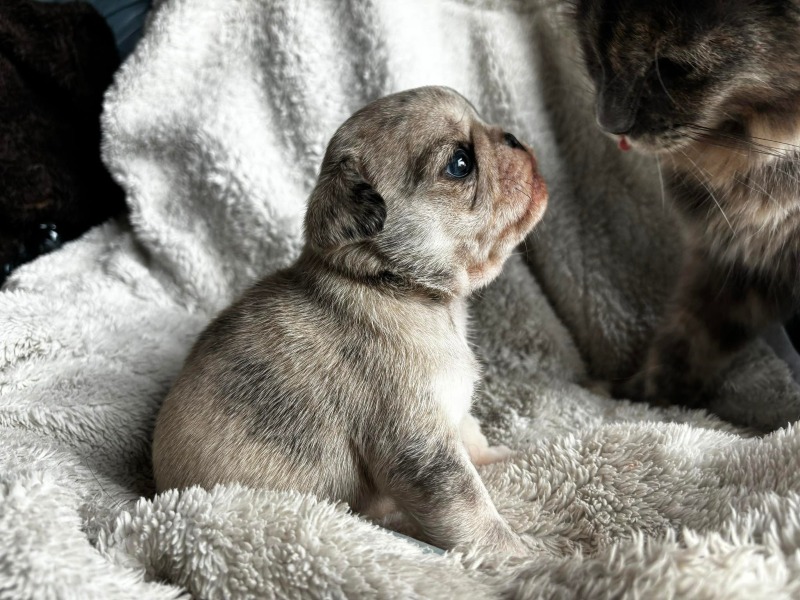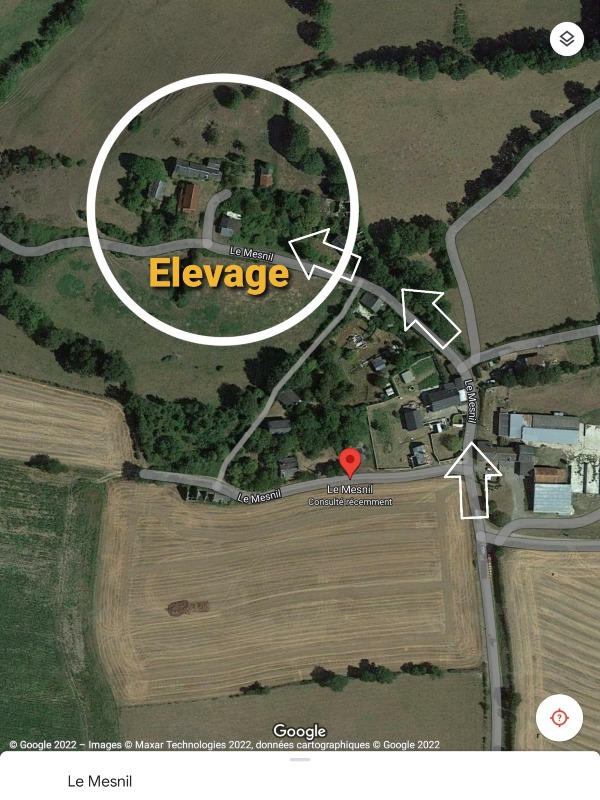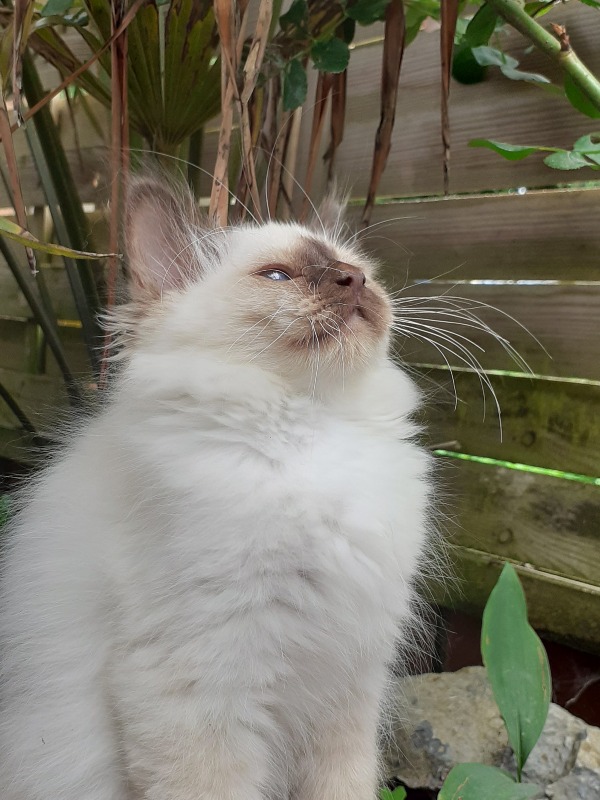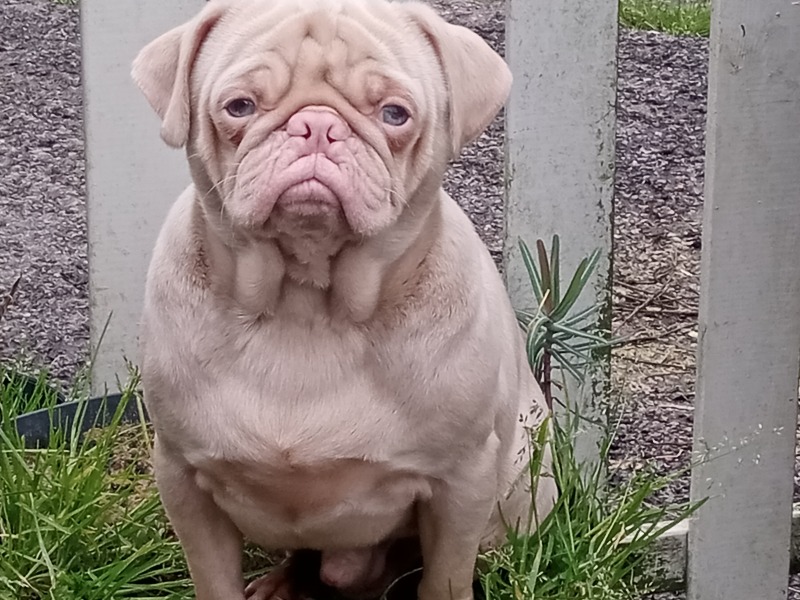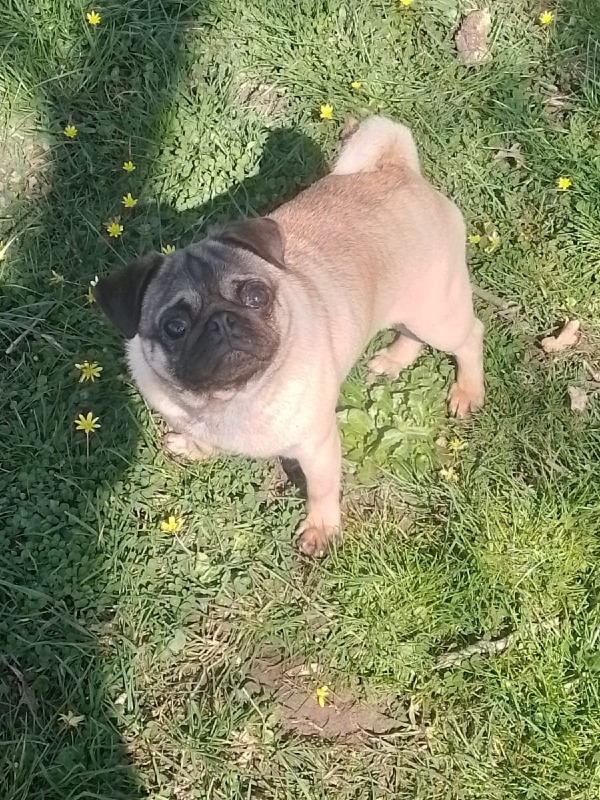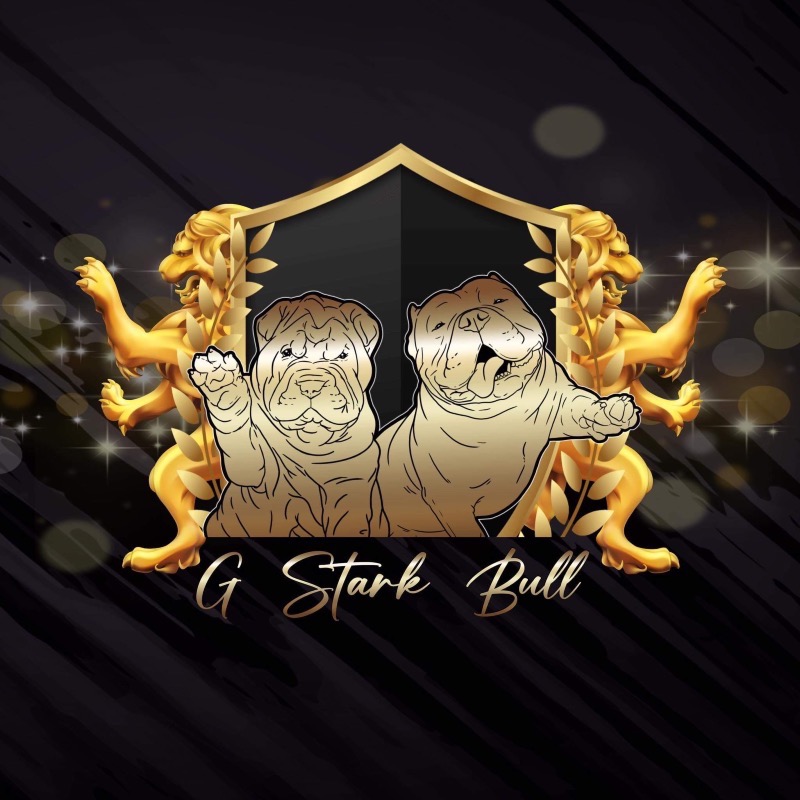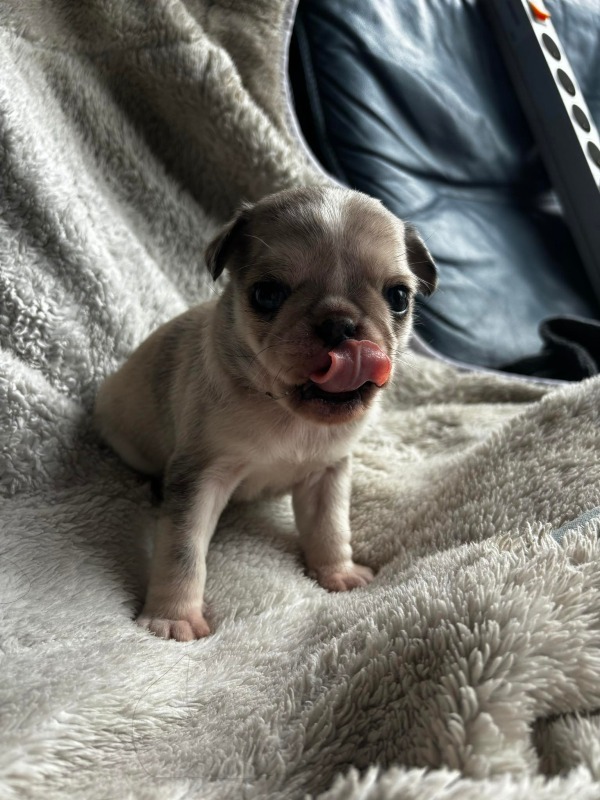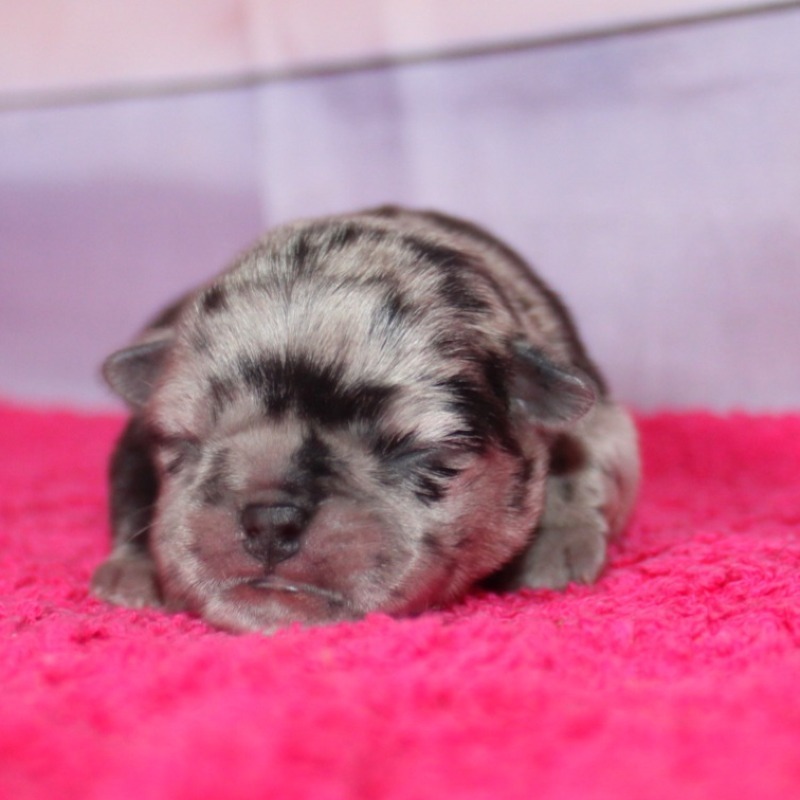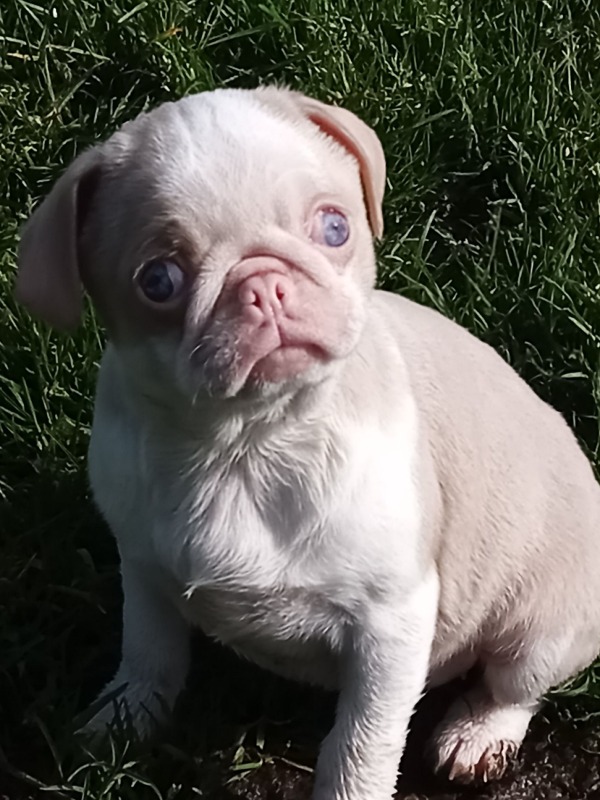Pug
Autres noms : Dutch bulldog, Mops
Discover the irresistible charm of the pug, a small dog with an adorable face and a playful personality. Loyal, affectionate, and friendly, it fits perfectly into families and adapts well to apartment living.
Awareness of acquiring an animal
Adopting or breeding a dog is a responsibility that must be carefully considered. Dogs are loyal companions that require time, attention, and constant care. Whether for leisure, passion, or professional breeding, it is crucial to understand the specific needs of each breed. Provide them with a loving and stimulating environment, and avoid any impulsive acquisition that could harm their well-being. Be a vigilant and committed owner for a happy and healthy companion.
To learn more about animal welfare, we invite you to consult our FAQ by clicking the button below:
Origins and history
The pug is a dog breed with origins that date back to ancient China, where it was cherished by members of royalty. These dogs were often kept in temples and regarded as precious companion animals. Over the centuries, the pug was introduced to Europe, particularly in Holland, where it quickly gained popularity among aristocratic circles.
During the 16th century, this breed made its way to England, captivating the nobility. The royal family, especially Queen Victoria, played a significant role in promoting the pug, contributing to its official recognition. Its popularity continued to grow in the following centuries, with breeders focusing on standardizing the characteristics of this breed, including its small size and unique physique.
The pug is known for its friendly and playful temperament, making it an excellent companion. Today, it is cherished in many households and is often recognized for its distinctive appearance, featuring a flat face and pronounced wrinkles. This breed continues to be a beloved presence within families around the world.
Physical characteristics
The pug is a compact and sturdy dog breed, distinguished by its charming appearance and affectionate behavior. Generally measuring between 25 and 30 centimeters at the withers, this dog is well-proportioned, with a square stature that gives it a distinctive look. Its weight typically ranges from 6 to 9 kg, making it an ideal companion for urban environments.
One of the most remarkable characteristics of the pug is its wrinkled, round face, which gives it a unique expression. Its large, round eyes are often very expressive, adding to its irresistible charm. The skull is broad and flat between the ears, while the muzzle is short, contributing to its unique appearance. The pug also has small, flexible ears that flop slightly to the sides of its head.
Regarding its coat, the pug sports a short, smooth, and shiny fur that withstands the elements well. The colors of its coat vary, including fawn, black, and occasionally less common shades like silver or apricot. Despite its small size, the pug stands out for its lively and playful personality, making it a beloved companion for families and individuals alike.
Character
The pug is a dog breed that stands out for its affectionate and playful character. These animals are known for their sociable and friendly nature. They easily integrate into families and generally get along well with children and other pets. Their joy of life and enthusiasm make them ideal companions for those seeking a loving presence.
One of the striking traits of the pug is its playful temperament. Often curious, they enjoy exploring their environment and interacting with their owners. Their energy is usually balanced: they are both lively and capable of moments of calm, which makes them adaptable to various lifestyles. They enjoy walks but are also content with toys at home to keep them entertained.
Despite their sometimes grumpy appearance, these dogs are very affectionate and often express their need for attention. They are known for their loyalty and attachment to their family. In short, the pug is a loyal companion that brings joy and tenderness to those around them.
Life expectancy
The life expectancy of dogs of this breed is generally between 12 and 15 years. However, as with all animals, several factors influence this duration. It is important to consider the care provided, nutrition, and regular physical exercise that contribute to their well-being and longevity.
Health issues are a crucial element to take into account. This breed is prone to certain health problems, including respiratory difficulties due to their morphology. Eye diseases, such as cataracts, can also affect their quality of life. Regular veterinary check-ups can help detect these issues at an early stage, which can increase life expectancy.
Moreover, the environment plays a significant role. A healthy living environment, without excessive stress, contributes to their development. Dogs benefit from mental and physical stimulation, making their daily life more enriching and enjoyable. Providing good socialization from a young age also helps prevent behavioral issues that can impact their overall well-being.
Exercise and activity needs
The pug is a dog breed known for its friendly temperament and distinctive appearance. Although it is often considered a companion dog, it is essential to meet its exercise and activity needs to maintain its physical and mental health.
First of all, the pug requires regular walks. Generally, two daily walks of about 20 to 30 minutes are sufficient to meet its needs. These outings allow it to expend energy and stimulate its senses. It is important to vary the routes and environments to enrich its experience.
Next, the pug also enjoys engaging in play. Activities such as fetch, tug-of-war, or even puzzle games can help it burn off energy while providing mental stimulation. These playtime moments strengthen the bond between the dog and its owner and help break the monotony.
Finally, although the pug needs exercise, it is crucial to ensure that it is not overworked, especially in hot weather. Due to its anatomy, it can be sensitive to heat, which is why it's important to pay attention to its well-being during outdoor activities. With appropriate attention to its exercise needs, the pug can lead a fulfilling and balanced life.
Recommended diet
The diet of a pug should be carefully balanced to meet its specific needs. Due to its morphology, with a short muzzle and a tendency towards obesity, it is crucial to monitor the amount and quality of the food provided. A diet rich in proteins, coming from lean meat sources, will help maintain good muscle mass and support its energy levels.
Carbohydrates should also be an integral part of its diet, but it is recommended to prioritize high-quality sources like brown rice or sweet potatoes. These foods not only provide energy but also offer fiber for optimal digestion. It is essential to avoid artificial ingredients and by-products, as they can harm the overall health of the animal.
Healthy fats, such as those found in fish or olive oils, can be added in small amounts to promote healthy skin and coat. Additionally, a supply of omega-3 fatty acids can help reduce inflammation.
Finally, it is advisable to divide food portions into several small meals throughout the day to prevent digestive issues. Always consult a veterinarian to adjust the diet based on the animal's age, weight, and physical activity level.
Training and obedience
The pug is a companion dog appreciated for its affectionate nature and endearing personality. To ensure effective training, it is essential to start at a young age. Socialization should be a priority, exposing the puppy to various environments, people, and other animals. This will help the dog develop self-confidence and reduce anxiety in new situations.
The pug is intelligent, but it can also be stubborn. Therefore, using positive reinforcement methods, such as rewards and praise, is recommended. Training sessions should be short and enjoyable, as these dogs cannot tolerate monotony. Patience is key: it is important to keep in mind that each dog learns at its own pace.
Finally, the pug needs moderate exercise. Although it is generally not very demanding physically, it is crucial to stimulate it mentally and physically. Interactive games and regular walks will contribute to its overall well-being, good mood, and health. Careful education and training will help forge a strong and harmonious relationship between the dog and its owner.
Behavior with children
The pug is a dog breed known for its friendly and playful personality. Generally, these dogs are kind and affectionate towards children, making them ideal companions for families. Their playful nature and ability to adapt to different environments help foster great interactions with younger ones.
Their small size and affectionate temperament often allow children to play with them without fear of injury. However, it is essential to remember that even though pugs are tolerant, they can have their own limits. It is important to teach children to respect these boundaries and to interact gently. Rough behaviors or tugging can disturb these dogs, which could lead to unnecessary stress.
Finally, training these dogs is crucial to ensure harmonious coexistence. Early and positive training helps establish clear rules and promotes a good relationship with children. In summary, with proper supervision and appropriate education, pugs can become excellent play companions for children.
Compatibility with Other Animals
The pug is a dog breed distinguished by its friendly and sociable nature. This affectionate disposition makes it a great companion for families and other pets. Generally, pugs get along well with other dogs, especially if they have been socialized from a young age. Their tendency to be playful and curious often makes them friendly towards their peers.
When it comes to cohabiting with cats, the dynamic can vary depending on the individual. Some pugs exhibit a strong play instinct, which may intrigue or even annoy a cat. However, with a proper introduction and gradual acclimatization, many pugs can live harmoniously with felines. It's important to monitor interactions in the beginning to avoid any unnecessary stress.
Finally, if the pug is in an environment with other animals, such as rodents or birds, it will be essential to watch its natural curiosity. A pug may have a more pronounced hunting instinct, which can sometimes lead to inappropriate behaviors towards smaller animals. In summary, when well-socialized and supervised, a pug can effectively integrate into a multi-pet household.
Grooming needs
Grooming and maintenance for Pug breed dogs are essential to ensure their health and well-being. Firstly, their short, dense coat requires regular brushing, typically once a week, to remove dead hair and prevent matting. Using a soft brush is recommended to avoid irritating their sensitive skin.
As for eye care, this breed is prone to ocular secretions. Therefore, it is important to clean their eyes daily with a soft, damp cloth to prevent the buildup of dirt and infections. The ears should also be checked regularly. It is crucial to gently clean the inside of the ears with an appropriate product to prevent ear infections.
Finally, dental hygiene is paramount. Brushing their teeth several times a week helps to prevent dental issues. Healthy teeth are essential for the quality of life of this breed. In summary, good maintenance of the coat, eyes, ears, and teeth is fundamental to ensuring the health and happiness of these adorable companions.
Health
The pug is a dog breed known for its affectionate nature and playful personality, but it is important to be aware of its health. Due to its morphology, which includes a short muzzle, the pug is predisposed to respiratory issues. This type of face can lead to obstructive airway syndromes, making physical exercise difficult in hot or humid weather.
Eye problems are also common in this breed, including keratitis and corneal ulcers. This is due to the shape of their eyes, which can be prone to irritations. Special attention to eye care is therefore essential to prevent complications.
Furthermore, pugs are prone to obesity due to their tendency to gain weight easily. An appropriate diet and regular physical activity are crucial to maintaining their health and avoiding related issues such as diabetes or joint diseases. Lastly, it is recommended to consult a veterinarian regularly to monitor their overall health and receive breed-specific advice.
Environment and habitat
The pug is a small dog breed, appreciated for its affectionate nature and joyful personality. Originating from China, these dogs adapt easily to various types of environments, whether urban or rural. Their compact size allows them to feel comfortable in apartments, provided they receive regular physical activity.
Regarding their habitat, it is crucial to provide them with a comfortable space that meets their needs. A calm and secure environment is ideal for reducing stress. Pugs tend to be sensitive to extreme temperatures; therefore, it is important to protect them from both cold and excessive heat.
Socially, these dogs are very sociable and need interaction with both humans and other dogs. Daily walks, playtime, and mental stimulation are essential for their well-being. Special attention should be paid to their health, particularly their respiratory system, which can be prone to issues due to their morphology. In summary, a loving environment and an active lifestyle are fundamental for the health and happiness of these devoted companions.
Name ideas
Choosing a name for a pug is an exciting step that deserves careful thought. The choice of a name should take into account your dog's personality, appearance, and even your personal preferences. A good name is often short, easy to pronounce, and stands out with a clear sound, which will facilitate your companion's learning.
Consider characteristics unique to pugs, such as their expressive face, affectionate temperament, and compact size. You can also draw inspiration from cultural references, characters from movies or books. Originality can be a plus as well, but it's important to make sure the name doesn’t sound like common commands to avoid any confusion when calling them.
Here are some name suggestions for your pug: Buddha, Pudding, Gizmo, Choco, Muffin, Tango, Biscuit, Zorro, Water Lily, Cuddly, Plush, Picasso, Rocco, Bubbles, Mimosa. These options evoke playful and affectionate traits, perfectly matching the nature of this adorable breed.
Average purchase price
The price of a purebred dog can vary depending on several factors, including the breeder, geographic location, and the animal's pedigree. Generally, for a dog of this breed, prices can range from 800 to 2500 euros. Puppies from prestigious bloodlines, capable of participating in competitions, tend to be more expensive.
Additionally, the breeder plays a crucial role in the price. Reputable and registered breeders who adhere to animal welfare standards and provide quality care will often charge higher prices than less scrupulous breeders. It is essential to choose a responsible breeder who conducts health tests on their dogs to avoid potential genetic issues.
It's also important to consider the additional costs associated with acquiring a puppy: vaccinations, microchipping, spaying/neutering, and initial supplies such as food, toys, and accessories. These expenses can quickly add up, making the initial investment more significant. In summary, the purchase price is just one part of the overall financial commitment associated with dog ownership.
Expenses
Owning a Pug involves various monthly costs that can vary depending on several factors. First of all, food is an essential expense. For a dog of this size, you should budget around 40 to 60 euros per month for quality food that meets its nutritional needs.
Next, veterinary fees need to be considered. An annual check-up can cost between 50 and 100 euros, but it's wise to budget around 20 to 30 euros per month in case care is needed, such as vaccinations, deworming, or potential medical treatments.
Dog hygiene is also an expense to take into account. Grooming sessions, which may be needed every two to three months, cost around 30 to 70 euros. Therefore, for an average monthly cost, you should plan for about 10 to 20 euros.
Finally, other expenses should be considered, such as accessories (toys, collars, leashes), health insurance, and potential boarding costs. In summary, a total budget of around 100 to 150 euros per month is reasonable to ensure the well-being of a Pug.
Destination and usage
The pug is a beloved companion dog known for its joyful character and distinctive appearance. Originally from China, these small dogs quickly integrated into European households, becoming loyal and adorable companions. Their compact size and affectionate personality make them ideal companions for families, as well as for individuals living alone or seniors. They adapt easily to various environments, whether it's a city apartment or a house with a garden.
The pug is often adopted for its sociable nature and friendly temperament. Renowned for being good family dogs, they form close bonds with their owners and generally get along well with children. Their need for affection and human interaction also makes them suitable for those seeking a companion to reduce isolation. Pugs are playful animals that love to have fun, making them perfect for leisure activities such as daily walks or play sessions.
Despite their affectionate nature, these dogs require special attention in terms of health. As pets, it is essential to ensure their well-being by monitoring their diet and exercise levels. Regular veterinary check-ups are also recommended to prevent health issues related to their physique. In summary, the pug is a breed that combines charm, sociability, and a zest for life, making it an excellent choice for anyone seeking a devoted companion in their home.
Legislation and regulation
The legislation regarding dog breeds, especially pugs, varies significantly from country to country and is often influenced by considerations of health, ethics, and public safety. In some countries, strict regulations are in place to protect animals from abuse and irresponsible breeding practices. For example, several nations have enacted laws that prohibit breeding practices aimed at accentuating physical traits that could lead to health problems.
In other regions, regulations focus more on possession restrictions. Some cities impose laws on breeds deemed potentially dangerous, although this breed is generally not included in those classifications. Conversely, countries like France or the United States prioritize educating owners and responsibility over breed stigma.
Finally, animal protection organizations and breed clubs promote standards of ethical breeding and encourage sterilization to limit overpopulation. This reflects a trend towards responsible breeding, regardless of the legal differences around the world.
Official recognition
The pug is a dog breed that enjoys official recognition in many countries around the world. This breed, known for its friendly temperament and unique appearance, is often appreciated for its playful and affectionate nature. In many European countries, such as France, the United Kingdom, and Germany, major kennel clubs recognize the pug and organize beauty events and competitions.
In the United States, the pug is also recognized by the American Kennel Club (AKC), an influential institution in the field of dog breeds. This recognition has helped increase the popularity of this breed among dog enthusiasts, making the pug a common choice among families.
In Asia, countries like Japan and China have seen a rise in the popularity of this breed. Breeders have adapted to the growing demand, and dedicated clubs have emerged to promote responsible breeding. However, in some regions, recognition may vary, and efforts are needed to ensure high breeding standards and the preservation of the breed's health.
In summary, the recognition of the pug is well-established in many countries, promoting its education and rigorous selection. Nevertheless, it remains essential to continue efforts to promote responsible breeding practices on a global scale.
Pedigrees
To obtain a pedigree for purebred pugs, there are several registries or breed clubs that ensure the registration of dogs and the issuance of pedigree certificates. The main club for this breed is often recognized at the national level and offers a rigorous registration process. This includes assessments of compliance with breed standards and health checks for the parents. These clubs also play a crucial role in promoting the breed and organizing events such as dog shows.
In addition to the national club, there may be specialized organizations in certain regions that also offer registration and pedigree services. These regional or local clubs may focus on preserving the specific characteristics of the breed and encouraging good breeding practices. They can organize competitions, meetings, and educational activities for breeders and owners.
To ensure that a recognized and respected pedigree is obtained, it is advisable to contact clubs affiliated with national or international canine federations. These entities guarantee high standards in breeding and registration, which contributes to the reputation and overall health of the breed. Breeders and owners are encouraged to educate themselves about these registries and choose the ones that best meet their needs and those of their animals.
Prohibitions
In several countries around the world, regulations concerning certain dog breeds can vary significantly, influenced by perceptions of safety and animal welfare. The pug, as a breed, is often less affected by strict bans compared to other breeds deemed more dangerous, but it can still be subject to specific restrictions, particularly due to prevalent health issues.
In Europe, some countries highlight animal welfare laws that may impact the breeding of this breed. Specific physical characteristics, such as the flattened nose, raise health concerns. Regulations may be implemented to promote responsible breeding, thereby limiting practices that exacerbate respiratory problems in these dogs.
In other regions, there is awareness around proper care and ethical pet shops that provide guidance to prospective owners. Therefore, while there may not be universal bans on this breed, health and welfare concerns influence regulations in various countries.
Breeders of Pug
Classified Ads of Pug
Breed clubs of pug
No of pug breed clubs are currently registered on Preeders.
If you would like to highlight your breed club, sign up for free now and be the first to appear on this page.

